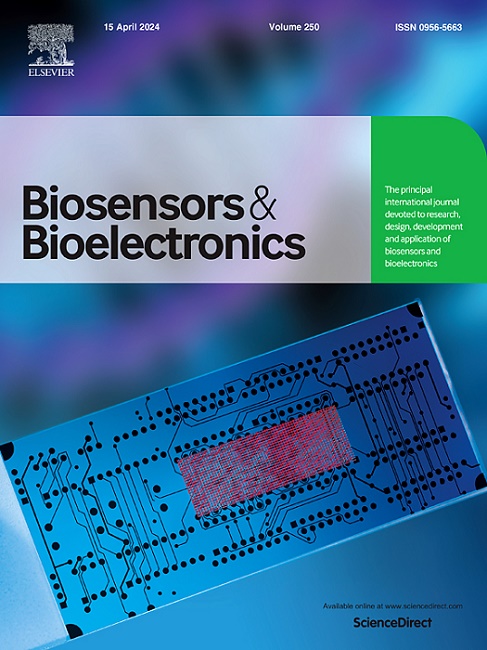A “turn-on” intracellular pH probe for the quantitative monitoring of lysosomal alkalization in living cells
IF 10.5
1区 生物学
Q1 BIOPHYSICS
引用次数: 0
Abstract
A slight elevation in lysosomal pH can lead to indigestion or nonspecific hydrolysis, thereby increasing the risk of various neurodegenerative diseases and cancer. Therefore, accurate monitoring of lysosomal pH changes in living cells is essential for the diagnosis and treatment of such diseases, despite the significant challenges involved. In this study, we synthesized a pH-dependent fluorescent probe, B26, which comprises 1,8-naphthalimide as the fluorescent chromophore, an N-(2-hydroxyethyl) piperazine group for lysosome targeting, and a hydroxyethyl group to increase solubility and regulate pKa. B26 demonstrated high sensitivity, selectivity, and reversibility in response to H+, and exhibited a remarkable 98-fold increase in fluorescence intensity between pH 2.0 and pH 11.0, with a pKa value of 7.0, highlighting its “turn-on” fluorescence property. Density functional theory calculations and 1H NMR titration revealed that the pH-sensing mechanism of B26 relies on the inhibition of photoinduced electron transfer from the N-(2-hydroxyethyl) piperazine group to the naphthalimide moiety under acidic conditions. Importantly, B26 effectively labeled lysosomes and displayed significant sensitivity to pH changes, facilitating the quantitative detection of pH shifts during lysosomal alkalization in living cells due to its elevated pKa. These findings suggest that B26 successfully addresses the limitations of existing lysosomal pH probes, particularly in detecting pH changes within the near-neutral range. Furthermore, both the zebrafish model and subcutaneous imaging support the application of B26 in in vivo settings. Given its exceptional properties, B26 holds enormous potential for the research and diagnosis of pH-related diseases.

一种用于活细胞中溶酶体碱化定量监测的“开启”细胞内pH探针
溶酶体pH值轻微升高可导致消化不良或非特异性水解,从而增加各种神经退行性疾病和癌症的风险。因此,尽管存在重大挑战,但准确监测活细胞中溶酶体pH值的变化对于诊断和治疗此类疾病至关重要。在本研究中,我们合成了一种ph依赖性荧光探针B26,它包括1,8-萘酰亚胺作为荧光发色团,一个N-(2-羟乙基)哌嗪基团用于溶酶体靶向,一个羟乙基用于增加溶解度和调节pKa。B26对H+具有较高的灵敏度、选择性和可逆性,在pH 2.0 ~ pH 11.0范围内,其荧光强度显著增加98倍,pKa值为7.0,具有“开启”荧光特性。密度泛函理论计算和1H NMR滴定结果表明,B26的ph感应机制依赖于在酸性条件下抑制N-(2-羟乙基)哌嗪基团向萘酰亚胺部分的光致电子转移。重要的是,B26能有效地标记溶酶体,并对pH变化表现出显著的敏感性,有助于定量检测活细胞中因pKa升高而导致的溶酶体碱化过程中的pH变化。这些发现表明B26成功地解决了现有溶酶体pH探针的局限性,特别是在检测近中性范围内的pH变化方面。此外,斑马鱼模型和皮下成像都支持B26在体内的应用。鉴于其特殊的性质,B26在ph相关疾病的研究和诊断方面具有巨大的潜力。
本文章由计算机程序翻译,如有差异,请以英文原文为准。
求助全文
约1分钟内获得全文
求助全文
来源期刊

Biosensors and Bioelectronics
工程技术-电化学
CiteScore
20.80
自引率
7.10%
发文量
1006
审稿时长
29 days
期刊介绍:
Biosensors & Bioelectronics, along with its open access companion journal Biosensors & Bioelectronics: X, is the leading international publication in the field of biosensors and bioelectronics. It covers research, design, development, and application of biosensors, which are analytical devices incorporating biological materials with physicochemical transducers. These devices, including sensors, DNA chips, electronic noses, and lab-on-a-chip, produce digital signals proportional to specific analytes. Examples include immunosensors and enzyme-based biosensors, applied in various fields such as medicine, environmental monitoring, and food industry. The journal also focuses on molecular and supramolecular structures for enhancing device performance.
 求助内容:
求助内容: 应助结果提醒方式:
应助结果提醒方式:


